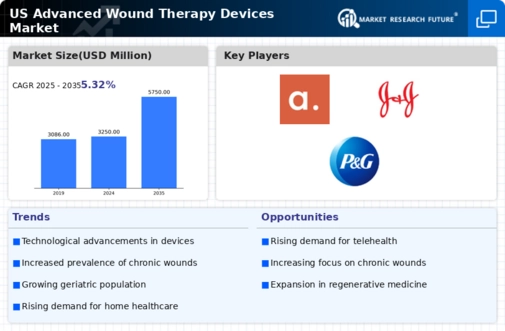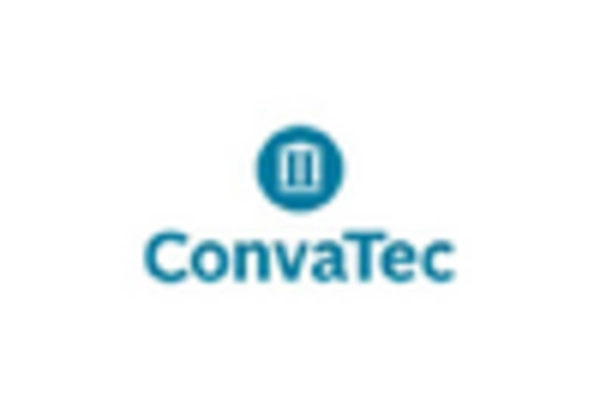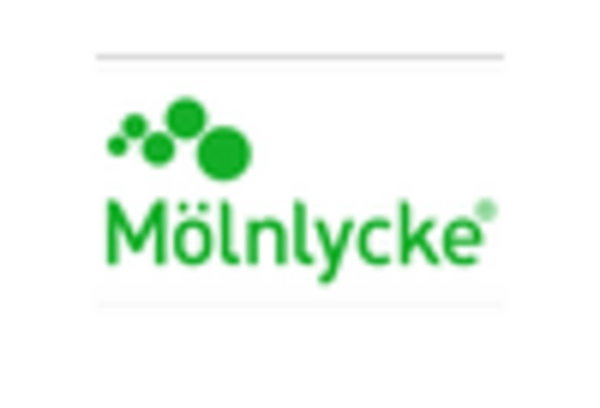Growing Awareness of Wound Care
Awareness regarding the importance of effective wound care is on the rise, positively impacting the advanced wound-therapy-devices market. Educational initiatives by healthcare organizations and advocacy groups are informing both patients and providers about the benefits of advanced wound management. This heightened awareness is leading to increased demand for specialized wound care products and services. As patients become more informed about their treatment options, they are more likely to seek advanced therapies, thereby driving market growth. The trend suggests that as awareness continues to grow, the advanced wound-therapy-devices market will likely see a corresponding increase in adoption rates.
Increased Healthcare Expenditure
The advanced wound-therapy-devices market benefits from rising healthcare expenditure in the US. With healthcare spending projected to reach $6 trillion by 2027, there is a growing emphasis on advanced medical technologies. This increase in funding allows healthcare facilities to invest in state-of-the-art wound care solutions, which are essential for treating complex wounds effectively. Moreover, the shift towards value-based care models encourages providers to adopt advanced wound-therapy-devices that demonstrate improved patient outcomes and reduced hospital stays. As a result, the market is likely to expand, driven by the financial resources allocated to innovative wound management solutions.
Rising Incidence of Chronic Wounds
Growth in the market is driven by the increasing prevalence of chronic wounds, such as diabetic ulcers and pressure sores. In the US, the incidence of diabetes is projected to rise, with estimates suggesting that approximately 34.2 million people are currently affected. This condition often leads to complications requiring advanced wound care solutions. Furthermore, the aging population, which is expected to reach 77 million by 2034, contributes to the demand for effective wound management. As the population ages, the likelihood of chronic wounds increases, thereby driving the need for advanced wound-therapy-devices. The market is anticipated to expand as healthcare providers seek innovative solutions to address these challenges.
Technological Innovations in Wound Care
Technological advancements play a pivotal role in shaping the advanced wound-therapy-devices market. Innovations such as bioengineered skin substitutes, negative pressure wound therapy, and advanced dressings are revolutionizing wound management. The market for these devices is projected to reach approximately $5 billion by 2026, reflecting a compound annual growth rate (CAGR) of around 6.5%. These technologies not only enhance healing rates but also improve patient outcomes, which is crucial in a healthcare landscape that increasingly prioritizes efficiency and effectiveness. As healthcare providers adopt these advanced solutions, the market is likely to witness substantial growth, driven by the demand for improved wound care.
Regulatory Support for Advanced Therapies
Regulatory bodies in the US are increasingly supportive of advanced wound-therapy-devices, which is fostering market growth. The Food and Drug Administration (FDA) has streamlined the approval process for innovative wound care technologies, allowing for quicker access to the market. This regulatory environment encourages manufacturers to invest in research and development, leading to the introduction of novel products. As a result, the advanced wound-therapy-devices market is likely to benefit from a steady influx of new technologies that enhance treatment options for patients. The supportive regulatory framework may also lead to increased competition, further driving innovation and market expansion.

















Leave a Comment